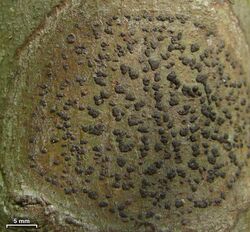Biology:Bathelium
| Bathelium | |
|---|---|

| |
| Bathelium carolinianum in North Carolina, USA | |
| Scientific classification | |
| Domain: | Eukaryota |
| Kingdom: | Fungi |
| Division: | Ascomycota |
| Class: | Dothideomycetes |
| Order: | Trypetheliales |
| Family: | Trypetheliaceae |
| Genus: | Bathelium Ach. (1803) |
| Type species | |
| Bathelium mastoideum Afzel. ex Ach. (1803)
| |
Bathelium is a genus of lichen-forming fungi in the family Trypetheliaceae.[1]
Taxonomy
The genus was circumscribed in 1803 by Swedish lichenologist Erik Acharius, with Bathelium mastoideum assigned as the type species.[2]
Description
Genus Bathelium features a [[Glossary of lichen terms#{{biology:{1}}}|{{Biology:{1}}}]] thallus (a protective outer layer) usually with olive-green to brownish or greyish hues. This genus is distinguished by the form of its ascomata, the spore-producing structures, which possess apical ostioles (openings at the top). These ascomata can be found either singly or in groups, and often form [[Glossary of lichen terms#{{biology:{1}}}|{{Biology:{1}}}]], a stroma made of both thallus tissue and bits of host tissue. They are noticeable, ranging from [[Glossary of lichen terms#{{biology:{1}}}|{{Biology:{1}}}]] to [[Glossary of lichen terms#{{biology:{1}}}|{{Biology:{1}}}]], and show a brown-black colouration, though in rare instances, they may have a whitish [[Glossary of lichen terms#{{biology:{1}}}|{{Biology:{1}}}]] (powdery) appearance. This is complemented by a peripheral layer made up of tightly packed cells.[3]
Within the ascomata, the [[Glossary of lichen terms#{{biology:{1}}}|{{Biology:{1}}}]], a tissue layer containing filamentous structures, is clear and hyaline (translucent). It comprises thin, interconnecting filaments known as [[Glossary of lichen terms#{{biology:{1}}}|{{Biology:{1}}}]]. The [[Glossary of lichen terms#{{biology:{1}}}|{{Biology:{1}}}]] number from one to eight per ascus. They are transversely septate to [[Glossary of lichen terms#{{biology:{1}}}|{{Biology:{1}}}]] (divided into compartments by cross walls), with thin septa and more or less angular [[Glossary of lichen terms#{{biology:{1}}}|{{Biology:{1}}}]]. These spores are [[Glossary of lichen terms#{{biology:{1}}}|{{Biology:{1}}}]], meaning they have a spindle-like shape, with either acute (pointed) or rounded ends, and are not constricted at the median septum. They appear hyaline, do not react to iodine (IKI−), and are encased in a gelatinous sheath.[3]
No conidiomata (structures responsible for asexual reproduction) have been identified in this genus. In terms of chemical properties, Bathelium frequently contains anthraquinones, compounds often present internally in pseudostromata. Lichexanthone, a fluorescent xanthone compound, is occasionally found within the genus.[3]
Species
- Bathelium albidoporum (Makhija & Patw.) R.C.Harris (1995)
- Bathelium austroafricanum (Zahlbr.) Aptroot & Lücking (2016)
- Bathelium boliviense Flakus & Aptroot (2016)[4] – Bolivia
- Bathelium carolinianum (Tuck.) R.C.Harris (1995)
- Bathelium compositum (Vain.) C.W.Dodge (1953)
- Bathelium connivens (Nyl.) Trevis. (1861)
- Bathelium duplex (Fée) C.W.Dodge (1953)
- Bathelium flavostiolatum Flakus & Aptroot (2016)[4] – Bolivia
- Bathelium inspersomastoideum Flakus & Aptroot (2016)[4] – Bolivia
- Bathelium lineare (C.W.Dodge) R.C.Harris (1995)
- Bathelium madreporiforme (Eschw.) Trevis. (1852)
- Bathelium mastoideum Afzel. ex Ach. (1803)
- Bathelium megaleium Kremp. (1880)
- Bathelium meristosporum Mont. & Bosch (1861)
- Bathelium mirabile Flakus, Kukwa & Aptroot (2016)[4] – Bolivia
- Bathelium nigroporum (Makhija & Patw.) Aptroot & Lücking (2016)
- Bathelium oligosporum (Mont. & Bosch) Trevis. (1861)
- Bathelium ostendatum (Kremp.) Müll.Arg. (1880)
- Bathelium phaeomelodes Müll.Arg. (1885)
- Bathelium porinosporum Lücking, M.P.Nelsen & Gueidan (2016)[5]
- Bathelium pruinolucens Aptroot & Lücking (2016)
- Bathelium pruinosum Flakus, Kukwa & Aptroot (2016)[4] – Bolivia
- Bathelium sphaericum (C.W.Dodge) R.C.Harris (1995)
- Bathelium subalbens (Nyl.) C.W.Dodge (1953)
- Bathelium sundaicum Müll.Arg. (1891)
- Bathelium tuberculosum (Makhija & Patw.) R.C.Harris (1995)
- Bathelium varium (Fée) Trevis. (1861)
- Bathelium velatum Müll.Arg. (1882)
References
- ↑ Wijayawardene, Nalin; Hyde, Kevin; Al-Ani, Laith Khalil Tawfeeq; Somayeh, Dolatabadi; Stadler, Marc; Haelewaters, Danny et al. (2020). "Outline of Fungi and fungus-like taxa". Mycosphere 11: 1060–1456. doi:10.5943/mycosphere/11/1/8.
- ↑ Acharius, E. (1803) (in la). Methodus qua Omnes Detectos Lichenes Secundum Organa Carpomorpha ad Genera, Species et Varietates Redigere atque Observationibus Illustrare Tentavit Erik Acharius. Stockholm: impensis F.D.D. Ulrich. p. 111. https://www.biodiversitylibrary.org/page/44218201.
- ↑ 3.0 3.1 3.2 Aptroot, André; Lücking, Robert (2016). "A revisionary synopsis of the Trypetheliaceae (Ascomycota: Trypetheliales)". The Lichenologist 48 (6): 763–982. doi:10.1017/s0024282916000487.
- ↑ 4.0 4.1 4.2 4.3 4.4 Flakus, Adam; Kukwa, Martin; Aptroot, André (2016). "Trypetheliaceae of Bolivia: an updated checklist with descriptions of twenty-four new species". The Lichenologist 48 (6): 661–692. doi:10.1017/S0024282915000559.
- ↑ Lücking, Robert; Nelsen, Matthew P.; Aptroot, André; Benatti, Michel Navarro; Binh, Nguyen Quoc; Gueidan, Cecile; Gutiérrez, Martha Cecilia; Jungbluth, Patricia et al. (2016). "A pot-pourri of new species of Trypetheliaceae resulting from molecular phylogenetic studies". The Lichenologist 48 (6): 639–660. doi:10.1017/S0024282916000475.
Wikidata ☰ Q10426933 entry
 |

